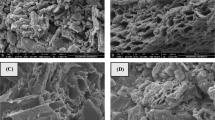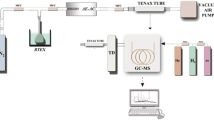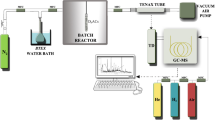Abstract
Formaldehyde and BTEX have been used for different industries and other activities. They release many ways that negatively affect the environment and human health due to inadequate ventilation and rapidly increasing oscillation conditions. The widely used technology, which activated carbon, is emerging new studies on air pollutants removal. This study was produced activated carbon for formaldehyde and BTEX removal from Aesculus hippocastanum L. biomass. It was used as organic waste that is abundant in nature. The carbonization was taken place at 600 °C and chemical activation by mixing with ZnCl2. The produced activated carbon has a surface area is 1858.42 m2/g. The adsorption capacity acquired from experimental data of VOCs were range from 638 to 1114 µg/g for AC-KN, respectively. The removal capacity of produced activated carbon was investigated in a batch reactor. Also, Freundlich and Langmuir’s isotherms were applied in the study. Accordingly, the experimental data were found compatible with both and a hybrid structure that the formaldehyde and BTEX adsorption by AC-KN was better fitted into the Freundlich model. Overall, the study showed that the produced AC-KN from the Aesculus hippocastanum L. biomass has a perfect potential in the removal of the formaldehyde and BTEX from indoor air.










Similar content being viewed by others
Data availability
Not applicable.
References
ACGIH (2011) Threshold limit values for chemical substances and physical agents and biological exposure indices. American Conference of Governmental Industrial Hygienists, Cincinnati
Aivalioti M, Papoulias P, Kousaiti A et al (2012) Adsorption of BTEX, MTBE and TAME on natural and modified diatomite. J Hazard Mater 207:117–127. https://doi.org/10.1016/j.jhazmat.2010.01.053
Amiri MJ, Roohi R, Arshadi M et al (2020) 2, 4-D adsorption from agricultural subsurface drainage by canola stalk-derived activated carbon: insight into the adsorption kinetics models under batch and column conditions. Environ Sci Pollut Res 1–15.https://doi.org/10.1007/s11356-020-08211-7
Awad R, Mamaghani AH, Boluk Y et al (2021) Synthesis and characterization of electrospun PAN-based activated carbon nanofibers reinforced with cellulose nanocrystals for adsorption of VOCs. Chem Eng J 410:128412. https://doi.org/10.1016/j.cej.2021.128412
Bellat JP, Bezverkhyy I, Weber G, Royer S, Averlant R, Giraudon JM, Lamonier JF (2015) Capture of formaldehyde by adsorption on nanoporous materials. J Hazard Mater. https://doi.org/10.1016/j.jhazmat.2015.07.078
Ceron-Breton JG, Bretón RMC, Kahl JD, Rico GS, Lozada SEC et al (2021) Concentrations, sources, and health risk associated with exposure to BTEX at ten sites located in an urban-industrial area in the Bajio Region, Mexico. Air Qual Atmos Health 14(5):741–761. https://doi.org/10.1007/s11869-021-00976-1
Chen PW, Kuo TC, Liu ZS et al (2021) Assessment of the mutagenicity of two common indoor air pollutants, formaldehyde and toluene. Indoor Air. https://doi.org/10.1111/ina.12832
Clinger JC, O’Shaughnessy PT (2019) Breakthrough analysis for filtering facepiece respirators impregnated with activated carbon. J Occup Environ Hyg 16(7):423–431. https://doi.org/10.1080/15459624.2019.1594838
Destro F, Hur I, Wang V, Abdi M, Feng X, Wood E et al (2021) Mathematical modeling and digital design of an intensified filtration-washing-drying unit for pharmaceutical continuous manufacturing. Chem Eng Sci 244:116803. https://doi.org/10.1016/j.ces.2021.116803
Dinh TV, Kim SY, Son YS, Choi IY, Park SR, Sunwoo Y et al (2015) Emission characteristics of VOCs emitted from consumer and commercial products and their ozone formation potential. Environ Sci Pollut Res 22(12):9345–9355. https://doi.org/10.1007/s11356-015-4092-8
El-Hashemy MAES, Alotaibi NF (2021) Purification of benzene-laden air by static adsorption of benzene onto activated carbon prepared from Diplotaxisacris biomass. Biomass Convers Biorefinery 1–15.https://doi.org/10.1007/s13399-021-01462-5
Fu C, Zhang L, Zhang K, Xiao B, Liu J, Luan Q, Liu J (2021) Effects of air-prepared atmosphere on the Pb2+ adsorption of sludge-based adsorbent. Biomass Convers Biorefinery 1–13.https://doi.org/10.1007/s13399-021-01706-4
Gałko G, Rejdak M, Tercki D, Bogacka M et al (2021) Evaluation of the applicability of polymeric materials to BTEX and fine product transformation by catalytic and non-catalytic pyrolysis as a part of the closed loop material economy. J Anal Appl Pyrol 154:105017. https://doi.org/10.1016/j.jaap.2021.105017
Giovanis E (2018) The relationship between teleworking, traffic and air pollution. Atmos Pollut Res. https://doi.org/10.1016/j.apr.2017.06.004
Goldstein AH, Nazaroff WW, Weschler CJ et al (2020) How do indoor environments affect air pollution exposure? Environ Sci Technol 55(1):100–108. https://doi.org/10.1021/acs.est.0c05727
González-García P (2018) Activated carbon from lignocellulosics precursors: a review of the synthesis methods, characterization techniques and applications.
Guo M, Yu W, Zhang S, Wang H et al (2020) A numerical model predicting indoor volatile organic compound volatile organic compounds emissions from multiple building materials. Environ Sci Pollut Res 27(1):587–596. https://doi.org/10.1007/s11356-019-06890-5
Haffner MJ, Oakes P, Demerdash A, Yammine KC, Watanabe K, Loukas M, Tubbs RS (2015) Formaldehyde exposure and its effects during pregnancy: recommendations for laboratory attendance based on available data. Clin Anat. https://doi.org/10.1002/ca.22623
Hajizadeh Y, Mokhtari M, Faraji M, Mohammadi A, Nemati S, Ghanbari R, Abdolahnejad A, Fard RF, Nikoonahad A, Jafari N, Miri M (2018) Trends of BTEX in the central urban area of Iran: a preliminary study of photochemical ozone pollution and health risk assessment. Atmos Pollut Res. https://doi.org/10.1016/j.apr.2017.09.005
Huang S, Wei W, Weschler LB, Salthammer T, Kan H, Bu Z, Zhang Y (2017) Indoor formaldehyde concentrations in urban China: preliminary study of some important influencing factors. Sci Total Environ. https://doi.org/10.1016/j.scitotenv.2017.02.187
Isinkaralar O, Isinkaralar K, Ekizler A, Ilkdogan C (2017) Changes in the amounts of CO2 and particulate matter in Kastamonu Province depending on weather conditions and locations. J Chem Biol Phys Sci 7(3):643–650. https://doi.org/10.24214/jcbps.D.7.3.64350
Isinkaralar K (2020) Removal of formaldehyde and BTEX in indoor air using activated carbon produced from horse chestnut (Aesculus hippocastanum L.) Shell. Ph.D. Thesis Hacettepe University, Institute of Science and Engineering, Department of Environmental Engineering. Ankara, Turkey
Jaiswal KK, Dutta S, Banerjee I, Pohrmen CB et al (2021) Photosynthetic microalgae–based carbon sequestration and generation of biomass in biorefinery approach for renewable biofuels for a cleaner environment. Biomass Convers Biorefinery 1–19.https://doi.org/10.1007/s13399-021-01504-y
Janhäll S (2015) Review on urban vegetation and particle air pollution–deposition and dispersion. Atmos Environ 105:130–137. https://doi.org/10.1016/j.atmosenv.2015.01.052
Javed M, Zahoor M, Mazari SA, Qureshi SS, Sabzoi N, Jatoi AS, Mubarak NM (2021) An overview of effect of process parameters for removal of CO 2 using biomass-derived adsorbents. Biomass Convers Biorefinery 1–19.https://doi.org/10.1007/s13399-021-01548-0
Karacocuk T, Sevik H, Isinkaralar K, Turkyilmaz A, Cetin M (2021) The change of Cr and Mn concentrations in selected plants in Samsun city center depending on traffic density. Landscape Ecol Eng. https://doi.org/10.1007/s11355-021-00483-6
Karmakar D, Deb K et al (2021) Ecophysiological responses of tree species due to air pollution for biomonitoring of environmental health in urban area. Urban Climate 35:100741. https://doi.org/10.1016/j.uclim.2020.100741
Kim MJ, Seo YK, Kim JH et al (2020) Impact of industrial activities on atmospheric volatile organic compounds in Sihwa-Banwol, the largest industrial area in South Korea. Environ Sci Pollut Res 27:28912–28930. https://doi.org/10.1007/s11356-020-09217-x
Lara-Ibeas I, Megias-Sayago C, Louis B, Le Calvé S (2020) Adsorptive removal of gaseous formaldehyde at realistic concentrations. J Environ Chem Eng 8(4):103986. https://doi.org/10.1016/j.jece.2020.103986
Li Z, Li Y, Zhu J (2021) Straw-based activated carbon: optimization of the preparation procedure and performance of volatile organic compounds adsorption. Materials 14(12):3284. https://doi.org/10.3390/ma14123284
Liu X, Zhang Y, Wu R, Ye M, Zhao Y, Kang J, Ma P, Li J, Yang X (2018) Acute formaldehyde exposure induced early Alzheimer-like changes in mouse brain. Toxicol Mech Methods. https://doi.org/10.1080/15376516.2017.1368053
Liu Y, Jia H, Li C et al (2019) Efficient removal of gaseous formaldehyde by amine-modified diatomite: a combined experimental and density functional theory study. Environ Sci Pollut Res 26:25130–25141. https://doi.org/10.1007/s11356-019-05758-y
Mirzaei A, Leonardi SG, Neri G (2016) Detection of hazardous volatile organic compounds (VOCs) by metal oxide nanostructures-based gas sensors: a review. Ceram Int 42(14):15119–15141. https://doi.org/10.1016/j.ceramint.2016.06.145
Mirzaie M, Talebizadeh AR, Hashemipour H (2021) Mathematical modeling and experimental study of VOC adsorption by Pistachio shell–based activated carbon. Environ Sci Pollut Res 28(3):3737–3747. https://doi.org/10.1007/s11356-020-10634-1
Na CJ, Yoo MJ, Tsang DCW, Kim HW, Kim KH (2019) High-performance materials for effective sorptive removal of formaldehyde in air. J Hazard Mater 366:452–465. https://doi.org/10.1016/j.jhazmat.2018.12.011
Nanda S, Mohammad J, Reddy SN, Kozinski JA, Dalai AK (2014) Pathways of lignocellulosic biomass conversion to renewable fuels. Biomass Convers Biorefinery 4(2):157–191. https://doi.org/10.1007/s13399-013-0097-z
Nielsen GD, Larsen ST, Wolkoff P (2013) Recent trend in risk assessment of formaldehyde exposures from indoor air.
Niu Z, Kong S, Zheng H, Yan Q, Liu J, Feng Y et al (2021) Temperature dependence of source profiles for volatile organic compounds from typical volatile emission sources. Sci Total Environ 751:141741. https://doi.org/10.1016/j.scitotenv.2020.141741
Park SH, Lim HB, Hong HJ, Kim HS, Yoon DK, Lee HW et al (2021) Health risk assessment for multimedia exposure of formaldehyde emitted by chemical accident. Environ Sci Pollut Res 28(8):9712–9722. https://doi.org/10.1007/s11356-020-11403-w
Paterson CA, Sharpe RA, Taylor T, Morrissey K (2021) Indoor PM2. 5, VOCs and asthma outcomes: a systematic review in adults and their home environments. Environ Res 111631. https://doi.org/10.1016/j.envres.2021.111631
Penney D, Benignus V, Kephalopoulos S, Kotzias D, Kleinman M, Verrier A (2010) Guidelines for indoor air quality. WHO Guidelines 9:454. https://doi.org/10.1186/2041-1480-2-S2-I1
Pivokonsky M, Kopecka I, Cermakova L, Fialova K, Novotna K, Cajthaml T et al (2021) Current knowledge in the field of algal organic matter adsorption onto activated carbon in drinking water treatment. Sci Total Environ 149455.https://doi.org/10.1016/j.scitotenv.2021.149455
Ramadoss R, Subramaniam D (2019) Removal of divalent nickel from aqueous solution using blue-green marine algae: adsorption modeling and applicability of various isotherm models. Sep Sci Technol 54(6):943–961. https://doi.org/10.1080/01496395.2018.1526194
Rehfuess E, World Health Organization (2006) Fuel for life: household energy and health. World Health Organization
Restrepo SYG, Rocha MH, Lora EES, Venturini OJ, Cobas VRM, Maya DMY (2021) Design and operation of a gas cleaning system for biomass gasification in a two-stage air-blown downdraft gasifier to meet quality requirements of solid oxide fuel cells. Biomass Convers Biorefinery 1–27.https://doi.org/10.1007/s13399-021-01796-0
Robert B, Nallathambi G (2021) Indoor formaldehyde removal by catalytic oxidation, adsorption and nanofibrous membranes: a review. Environ Chem Lett 1–29.https://doi.org/10.1007/s10311-020-01168-6
Ryu DY, Shimohara T, Nakabayashi K, Miyawaki J, Park JI, Yoon SH (2019) Urea/nitric acid co-impregnated pitch-based activated carbon fiber for the effective removal of formaldehyde. J Ind Eng Chem 80:98–105. https://doi.org/10.1016/j.jiec.2019.07.036
Saleem J, Shahid UB, Hijab M, Mackey H, McKay G (2019) Production and applications of activated carbons as adsorbents from olive stones. Biomass Convers Biorefinery 9(4):775–802. https://doi.org/10.1007/s13399-019-00473-7
Savas DS, Sevik H, Isinkaralar K, Turkyilmaz A et al (2021) The potential of using Cedrus atlantica as a biomonitor in the concentrations of Cr and Mn. Environ Sci Pollut Res 1–8.https://doi.org/10.1007/s11356-021-14826-1
Scherzinger M, Kaltschmitt M (2021) Thermal pre-treatment options to enhance anaerobic digestibility–a review. Renew Sustain Energy Rev 137:110627. https://doi.org/10.1016/j.rser.2020.110627
Sevik H, Isinkaralar K, Isinkaralar O (2018) Indoor air quality in hospitals: the case of Kastamonu Turkey. J Chem Biol Phys Sci Sect D 9(1):067–073. https://doi.org/10.24214/jcbps.D.9.1.06773
Sovacool BK, Griffiths S, Kim J, Bazilian M (2021) Climate change and industrial F-gases: a critical and systematic review of developments, sociotechnical systems and policy options for reducing synthetic greenhouse gas emissions. Renew Sustain Energy Rev 141:110759. https://doi.org/10.1016/j.rser.2021.110759
Sun J, Shen Z, Zhang Y, Zhang Z, Zhang Q, Zhang T et al (2019) Urban VOC profiles, possible sources, and its role in ozone formation for a summer campaign over Xi’an, China. Environ Sci Pollut Res 26(27):27769–27782. https://doi.org/10.1007/s11356-019-05950-0
Teimouri Z, Salem A, Salem S (2019) Regeneration of wastewater contaminated by cationic dye by nanoporous activated carbon produced from agriculture waste shells. Environ Sci Pollut Res 26(8):7718–7729. https://doi.org/10.1007/s11356-018-04094-x
Tham YJ, Latif PA, Abdullah AM, Shamala-Devi A, Taufiq-Yap YH (2011) Performances of toluene removal by activated carbon derived from durian shell. Biores Technol 102(2):724–728. https://doi.org/10.1016/j.biortech.2010.08.068
Turkyilmaz A, Cetin M, Sevik H, Isinkaralar K, Saleh EAA (2020) Variation of heavy metal accumulation in certain landscaping plants due to traffic density. Environ Dev Sustain 22(3):2385–2398. https://doi.org/10.1007/s10668-018-0296-7
Turkyilmaz A, Sevik H, Isinkaralar K, Cetin M (2018) Using Acer platanoides annual rings to monitor the amount 520 of heavy metals accumulated in air. Environ Monit Assess 190:578. https://doi.org/10.1007/s10661-018-5216956-0
Turkyilmaz A, Sevik H, Isinkaralar K, Cetin M (2019) Use of tree rings as a bioindicator to observe atmospheric heavy metal deposition. Environ Sci Pollut Res 26(5):5122–5130. https://doi.org/10.1007/s11356-018-3962-2
UNION P (2008) Directive 2008/50/EC of the European Parliament and of the Council of 21 May 2008 on ambient air quality and cleaner air for Europe. Official Journal of the European Union
USEPA (2020) —Measurement of Formaldehyde Emissions From Natural Gas-Fired Stationary Sources—Acetyl Acetone Derivitization Method Environmental Protection Agency. https://www.epa.gov/sites/default/files/2020-12/documents/method_323.pdf. Accessed 9/7/2020
Wang H, Wang B, Li J, Zhu T (2019) Adsorption equilibrium and thermodynamics of acetaldehyde/acetone on activated carbon. Sep Purif Technol 209:535–541. https://doi.org/10.1016/j.seppur.2018.07.076
WHO (2000) Air Quality Guidelines for Europe, 2nd edn, European Series, No. 91. WHO Regional Publications, Copenhagen
Wu J, Ahn J, Lee J (2021) Characterization of gold deportment and thiosulfate extraction for a copper‑gold concentrate treated by pressure oxidation. Hydrometallurgy 105771.https://doi.org/10.1016/j.hydromet.2021.105771
Xu X, Guo Y, Shi R, Chen H, Du Y, Liu B et al (2021) Natural honeycomb-like structure cork carbon with hierarchical micro-mesopores and N-containing functional groups for VOCs adsorption. Appl Surf Sci 565:150550. https://doi.org/10.1016/j.apsusc.2021.150550
Yusoff MNAM, Zulkifli NWM, Sukiman NL, Chyuan OH, Hassan MH, Hasnul MH et al (2021) Sustainability of palm biodiesel in transportation: a review on biofuel standard, policy and international collaboration between Malaysia and Colombia. Bioenergy Res 14(1):43–60. https://doi.org/10.1007/s12155-020-10165-0
Zhang G, Lei B, Chen S, Xie H, Zhou G (2021) Activated carbon adsorbents with micro-mesoporous structure derived from waste biomass by stepwise activation for toluene removal from air. J Environ Chem Eng 9(4):105387. https://doi.org/10.1016/j.jece.2021.105387
Zhu L, Shen D, Luo KH (2020) A critical review on VOCs adsorption by different porous materials: species, mechanisms and modification methods. J Hazard Mater 389:122102. https://doi.org/10.1016/j.jhazmat.2020.122102
Acknowledgements
This study is produced from the Ph.D. thesis titled “Removal of Formaldehyde and BTEX in Indoor Air Using Activated Carbon Produced from Horse Chestnut (Aesculus hippocastanum L.) Shell” conducted at Hacettepe University, Ankara, Türkiye, Graduate School of Science and Engineering, Department of Environmental Engineering.
Author information
Authors and Affiliations
Contributions
KI, raw material collection and/or processing analysis and/or interpretation; AT, materials and processing analysis; GG, conceptualization, methodology, and literature search.
Corresponding author
Ethics declarations
Ethics approval
Not applicable.
Consent to participate
Not applicable.
Consent for publication
Not applicable.
Competing interests
The authors declare no competing interests.
Additional information
Publisher's note
Springer Nature remains neutral with regard to jurisdictional claims in published maps and institutional affiliations.
Rights and permissions
About this article
Cite this article
Isinkaralar, K., Gullu, G. & Turkyilmaz, A. Experimental study of formaldehyde and BTEX adsorption onto activated carbon from lignocellulosic biomass. Biomass Conv. Bioref. 13, 4279–4289 (2023). https://doi.org/10.1007/s13399-021-02287-y
Received:
Revised:
Accepted:
Published:
Issue Date:
DOI: https://doi.org/10.1007/s13399-021-02287-y




